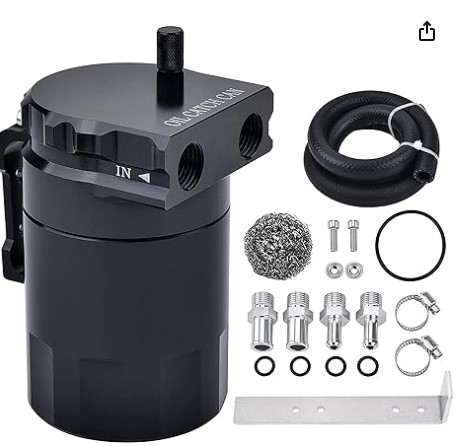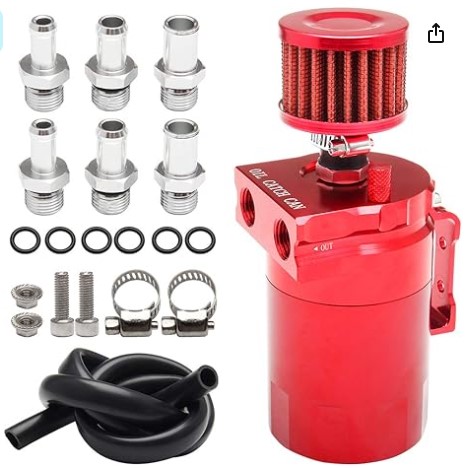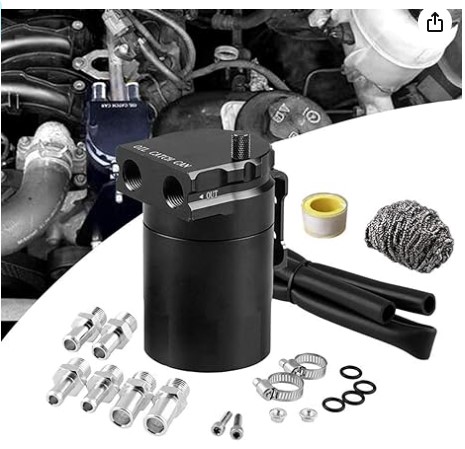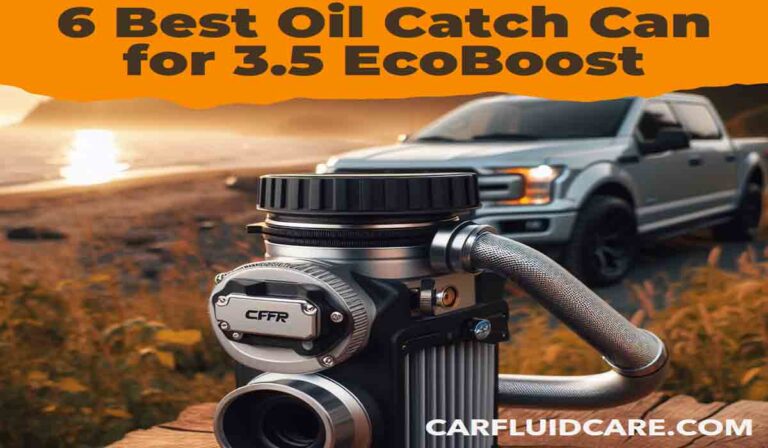Why Are Oil Catch Cans Illegal: Unraveling the Regulations

If a catch can vents accumulated oil vapors and gases directly to the atmosphere, it is illegal as it bypasses emission control systems and increases air pollution. This violates environmental regulations in most regions.
Closed Loop System: Catch cans that function as closed-loop systems are generally legal. These systems collect the oil vapors but re-introduce them back into the intake manifold after separating the oil. This maintains the car’s original airflow and emission control functionality.
Confusion and Gray Areas:
- Some jurisdictions might have specific regulations regarding catch can installations, so it’s always best to check local laws and emission regulations before installing one.
- Catch can designs vary, with some incorporating filters or baffles to improve oil separation and potentially allowing venting in specific cases. However, the legality often depends on the complete setup and the specific regulations in your area.
Oil catch cans themselves are not inherently illegal. In fact, they are often used in the automotive aftermarket to reduce the amount of oil vapors and contaminants that can enter the intake system of an internal combustion engine. The purpose of an oil catch can is to capture and separate oil and other contaminants from the air that circulates through the engine.
However, the legality of oil catch cans may depend on the specific regulations and laws in your region or country. In some places, modifications to the emissions or pollution control systems of vehicles may be subject to regulations, and any changes made to a vehicle’s emissions system could potentially be considered illegal.
Additionally, some areas may have specific laws regarding the installation of aftermarket parts, and failure to comply with these regulations could result in penalties or fines.
The key takeaway is that avoiding venting to the atmosphere is crucial for keeping your catch can legal. Opt for a closed-loop system and double-check your local regulations to ensure compliance.
What does an oil catch can do?
An oil catch can serves as a protective barrier in your engine’s system, intercepting and collecting oil vapor and contaminants before they can re-enter the intake manifold. Here’s what it does:
1. Protects Intake System:
- Prevents oil buildup: Oil vapor from the crankcase can coat intake valves and sensors, causing performance issues and reduced fuel efficiency. The catch can traps this oil, keeping the intake system clean.
- Reduces carbon buildup: The oil vapor can also mix with fuel and form carbon deposits on your intake valves, leading to rough idle, power loss, and even engine damage. The catch can minimizes this risk.
2. Improves Engine Performance and Life:
- Maintains cleaner combustion: By keeping the intake clean, the catch can allows for proper air-fuel mixture, leading to cleaner and more efficient combustion. This can boost power and improve fuel economy.
- Reduces wear and tear: Oil deposits in the intake can clog passages and cause excessive wear on pistons and other engine components. The catch can minimizes this, potentially extending engine life.
However, oil catch cans aren’t always necessary and might not be suitable for all vehicles. Generally, they’re beneficial for:
- High-performance engines: These engines often experience more blow-by (leakage of combustion gases into the crankcase) that contributes to oil vapor buildup.
- Direct injection engines: These engines don’t spray fuel directly on the intake valves, leaving them more susceptible to oil deposits.
- Modified engines: Modifications can create more blow-by and benefit from the catch can’s filtering role.
Read More About Function Of Turbocharger In Diesel Engine :Boosting Performance
Best oil catch can
1. EVIL ENERGY Baffled Oil Catch Can Review: pcv oil catch can
EVIL ENERGY brings you an innovative solution to maintain the optimal performance of your vehicle with their Baffled Oil Catch Can. This universal oil separator catch can, crafted from high-quality aluminum in a sleek black finish, offers a range of features designed to enhance your engine’s longevity and efficiency.

Features:
- Universal Compatibility: The EVIL ENERGY Baffled Oil Catch Can is engineered to fit most cars, ensuring hassle-free installation. This universal application makes it a versatile choice for a wide range of vehicles.
- Optimal Size: With a hose length of 31.5 inches, a hose ID of 3/8″, and a hose OD of 2/3″, this catch can is designed to accommodate various engine configurations. The M16*1.5 thread on the inlet and outlet ensures a secure and leak-free connection. The can itself boasts a generous 300ml capacity, providing ample space for oil collection.
- Baffled Design: The innovative baffle design allows for easy disassembly in a rotary manner. Adding steel balls to the baffle increases the surface area of steam condensation, effectively capturing oil and preventing it from entering the intake system.
- Temperature-Sensitive Note: The product includes a cautionary note highlighting the importance of maintenance in freezing conditions. In colder climates, the crank vent system may generate increased moisture, potentially leading to freezing. Regular cleaning or the installation of the original PCV hose is recommended under such conditions.
- Warranty Assurance: EVIL ENERGY stands behind the quality of their product by offering a 3-month warranty. This commitment reflects their confidence in the durability and functionality of the Baffled Oil Catch Can.
Benefits:
- Improved Engine Efficiency: By preventing oil and contaminants from entering the intake system, the catch can helps maintain cleaner air and enhances overall engine efficiency.
- Universal Application: The catch can’s universal compatibility ensures that it can be easily integrated into various car models, providing a convenient solution for car enthusiasts and mechanics alike.
- Baffled Design for Enhanced Performance: The rotary disassembly of the baffle, coupled with the option to add steel balls, maximizes oil capture efficiency, contributing to better engine performance.
Applications:
The EVIL ENERGY Baffled Oil Catch Can is ideal for:
- Enthusiasts looking to enhance engine performance
- Mechanics seeking a universal solution for various vehicle models
- Those operating vehicles in freezing climates who require efficient oil capture and moisture management
Pros:
- Universal compatibility for versatile application
- Baffled design with customizable steel ball addition
- Generous 300ml capacity
- Temperature-sensitive caution for optimal performance
- 3-month warranty for added assurance
Cons:
- Weekly cleaning in freezing conditions may be required for optimal performance.
2. Top10 Racing Aluminum 350ml Oil Catch Can Tank Kit Review
Top10 Racing introduces the Aluminum 350ml Oil Catch Can Kit, a polished, baffled reservoir designed to enhance engine efficiency and longevity. This universal kit, constructed from premium aluminum, offers a range of features that set it apart as a top-tier choice for automotive enthusiasts and professionals alike.

Features:
- Oil Vapor Management: The primary purpose of the Oil Catch Can is to cool hot oil vapor, turning it into liquid and effectively catching oil and moisture vapor. This not only keeps the engine clean but also prolongs its life. The inclusion of a built-in dipstick for fluid level checks and a removable bottom for easy draining enhances its reusability and simplifies the cleaning process.
- Premium Aluminum Build: Crafted from high-quality aluminum, this 350ml Oil Catch Can ensures enhanced strength and durability. The polished finish adds a touch of style to the engine bay while guaranteeing long-term stable performance.
- Versatile Adapter Sizes: The kit includes three different adapter sizes (6mm, 8mm, 10mm) to accommodate various hose sizes. Each adapter comes with O-ring gaskets to prevent potential oil leakage, ensuring a secure and leak-free fit.
- Fuel Consumption Reduction: One notable benefit of the Top10 Racing Oil Catch Can Kit is its ability to effectively reduce fuel consumption in high-speed and turbine engines. This feature contributes not only to better fuel efficiency but also to a more environmentally friendly driving experience.
- Warranty Assurance: Top10 Racing stands behind the quality of their product by offering a 12-month warranty for the baffled oil catch can kit.
Benefits:
- Enhanced Engine Longevity: By capturing oil and moisture vapor, the Oil Catch Can contributes to a cleaner engine, ultimately prolonging its life.
- Stylish Design: The polished aluminum construction not only ensures durability but also adds a sleek and stylish aesthetic to the engine bay.
- Versatile Adapters: The inclusion of three adapter sizes with O-ring gaskets enhances the kit’s adaptability to different hose sizes, promoting ease of installation.
- Fuel Efficiency Improvement: The ability to reduce fuel consumption in high-speed and turbine engines adds a practical and eco-friendly dimension to the kit’s benefits.
Applications:
The Top10 Racing Aluminum 350ml Oil Catch Can Kit is suitable for:
- Automotive enthusiasts seeking enhanced engine performance
- Mechanics looking for a durable and stylish oil catch can solution
- Drivers aiming to improve fuel efficiency in high-speed and turbine engines
Pros:
- Premium aluminum construction for strength and durability
- Versatile adapter sizes with O-ring gaskets
- Fuel consumption reduction for improved efficiency
- Stylish polished finish
- 12-month warranty for added customer confidence
Cons:
- None reported.
3. RULLINE Universal 350ml Oil Catch Can Tank 0046 Aluminum Polish
RULLINE introduces the Universal 350ml Oil Catch Can, a meticulously crafted and polished aluminum reservoir designed to enhance engine efficiency and promote engine longevity. This black catch can is packed with features that make it a standout choice for automotive enthusiasts and mechanics alike.

Features:
- Engine Cleanliness: The primary function of the RULLINE Oil Catch Can is to capture oil and moisture from PCV/CCV air, preventing the buildup of carbon and sludge in the intake system and the engine. This not only keeps the engine clean but also contributes to extending its overall lifespan.
- Leakage Prevention: The catch can boasts a fully TIG welded construction and comes equipped with O-ring gaskets in fittings, ensuring a superior seal. This feature makes it an efficient and reliable solution for preventing oil leakage, providing peace of mind for users.
- Oil Dipstick Convenience: The inclusion of an oil dipstick adds a layer of user-friendly functionality. Checking the fluid level in the catch can is made convenient without the need for frequent opening, allowing users to monitor the catch can’s status effortlessly.
- Superior Quality Aluminum: Crafted from high-quality 0046 aluminum, this catch can offers added strength and durability. The fully TIG welded construction not only ensures robustness but also makes the catch can lightweight and corrosion-resistant.
- Universal Compatibility: With a 350ml capacity and three types of adapters, the RULLINE Oil Catch Can is designed to be universal, fitting most cars. This adaptability makes it a versatile and practical solution for a wide range of vehicles.
Benefits:
- Enhanced Engine Life: By preventing the accumulation of carbon and sludge in the intake system, the catch can plays a crucial role in keeping the engine clean and extending its overall lifespan.
- Leak-Free Operation: The fully TIG welded construction and O-ring gasket fittings provide excellent sealing, ensuring a leak-free performance and peace of mind for users.
- User-Friendly Design: The inclusion of an oil dipstick simplifies the process of checking the fluid level in the catch can, enhancing user convenience.
- High-Quality Construction: The use of premium 0046 aluminum not only ensures strength and durability but also makes the catch can lightweight and resistant to corrosion.
Applications:
The RULLINE Universal 350ml Oil Catch Can is suitable for:
- Automotive enthusiasts seeking to optimize engine performance
- Mechanics looking for a reliable and efficient oil catch can solution
- Owners of various car models due to its universal compatibility
Pros:
- Premium 0046 aluminum construction for strength and durability
- Leak prevention with fully TIG welded and O-ring gasket fittings
- Oil dipstick for easy fluid level checks
- Universal compatibility with three types of adapters
- Stylish black finish adds aesthetic appeal
Cons:
- None reported.
Oil catch can pros and cons
An oil catch can is a device installed in your car’s engine to capture and collect oil vapor and contaminants before they re-enter the intake manifold. It boasts potential benefits for specific engines, but also has some drawbacks to consider. Let’s weigh the pros and cons:
Pros:
- Prevents oil buildup: Oil vapor from the crankcase can coat intake valves and sensors, causing performance issues like reduced power, rough idle, and increased fuel consumption. The catch can prevents this, keeping the intake system clean.
- Reduces carbon buildup: Oil vapor can mix with fuel and form carbon deposits on intake valves, leading to further performance problems and even engine damage. The catch can minimizes this risk.
- Improves engine performance and life: By keeping the intake clean, the catch can allows for proper air-fuel mixture, leading to cleaner and more efficient combustion. This can boost power and improve fuel economy, while also reducing wear and tear on engine components.
- Particularly beneficial for:
- High-performance engines: These often experience more blow-by (leakage of combustion gases into the crankcase) that contributes to oil vapor buildup.
- Direct injection engines: These engines don’t spray fuel directly on the intake valves, leaving them more susceptible to oil deposits.
- Modified engines: Modifications can create more blow-by and benefit from the catch can’s filtering role.
Cons:
- Not always necessary: While beneficial for some, oil catch cans are not essential for all vehicles. Modern engines often have efficient PCV systems that handle oil vapor adequately. Consult your mechanic to see if you really need one.
- Installation can be complex: Installing a catch can requires modifying the PCV system hoses. Improper installation can cause problems, so a qualified mechanic is recommended.
- Potential warranty issues: Modifying the PCV system might void your engine warranty. Check your warranty conditions before installing a catch can.
- Cost: Oil catch cans range in price, but they can be a significant investment.
- Maintenance: Catch cans need periodic emptying and cleaning, adding to your maintenance routine.
- Legal considerations: In some regions, venting oil vapor directly to the atmosphere is illegal. Ensure your chosen catch can re-routes clean air back into the intake to comply with regulations.
Overall:
Oil catch cans offer potential performance and longevity benefits for specific engines, particularly those prone to oil and carbon buildup. However, consider the potential drawbacks like cost, complexity, and legal concerns before making a decision. Consult your mechanic and research your specific vehicle to determine if a catch can is right for you.
Oil catch can installation diagram
Oil catch can maintenance
Oil catch can maintenance is crucial to ensure it functions properly and protect your engine. Here’s a guide on how to do it yourself:
Frequency:
- The frequency depends on your driving habits and the amount of blow-by your engine produces. Generally, it’s recommended to empty and clean the catch can every 3,000 to 5,000 miles, or more often if you drive hard or in dusty conditions.
Materials:
- Safety glasses and gloves
- Rags
- Funnel
- Container for drained oil
- Catch can cleaning solvent (brake cleaner or degreaser)
- Replacement filter (if applicable)
Steps:
- Locate the catch can: It’s usually mounted in the engine bay near the PCV valve.
- Place the container under the drain plug.
- Loosen the drain plug and let the oil drain completely.
Clean the catch can:- Remove any large debris with a rag.
- Spray the inside with the cleaning solvent and let it sit for a few minutes.
- Use a rag or brush to scrub any stubborn deposits.
- Rinse with clean water and dry thoroughly.
- Replace the filter (if applicable): Most catch cans have a replaceable filter that traps smaller particles. Consult your catch can manual for specific instructions on filter replacement.
Reinstall the drain plug and tighten it securely. - Check for leaks and ensure all hoses are properly connected.
- Dispose of the drained oil and cleaning solvent responsibly.
Additional tips:
- It’s a good idea to check the oil level in your catch can after every oil change to get a sense of how much oil it’s collecting.
- If you notice a significant amount of oil in your catch can, it could indicate a problem with your engine. Consult a mechanic if you’re concerned.
- Avoid using harsh chemicals or abrasives when cleaning your catch can, as they could damage the internal components.
By following these simple steps, you can keep your oil catch can functioning properly and protect your engine from harmful oil and carbon buildup.
Read Also How Does A Supercharger Work- Types, Principle & More
Do I need an oil catch can?
Reasons to consider an oil catch can:
- High-performance engine: Engines operating at high power or under heavy load often experience more blow-by (leakage of combustion gases into the crankcase), leading to increased oil vapor in the intake system. A catch can can help minimize this.
- Direct injection engine: These engines don’t spray fuel directly on intake valves, making them more susceptible to oil buildup and deposits. A catch can can prevent this build-up.
- Modified engine: Modifications like forced induction can increase blow-by and benefit from a catch can’s filtering role.
- Excessive oil consumption: If you notice your oil level dropping significantly between changes, a catch can might help reduce oil buildup in the intake and potentially slow down consumption.
However, oil catch cans are not always necessary:
- Modern engines: Many modern engines have efficient PCV systems that handle oil vapor adequately. Installing a catch can might not offer significant benefits.
- Light driving: If you primarily drive short distances under light loads, your engine probably isn’t producing enough oil vapor to warrant a catch can.
- Cost and complexity: Installation can require modifying the PCV system hoses, and the cans themselves can be expensive.
- Potential warranty complications: In some cases, modifying the PCV system might void your engine warranty.
Here’s what I recommend:
- Consult your mechanic: Discuss your needs and driving habits with a qualified mechanic who can assess whether a catch can would be beneficial for your specific vehicle.
- Research your car model: Look for information online or in forums about other owners of your car model and their experiences with oil catch cans.
- Consider the downsides: Weigh the potential benefits against the cost, complexity, and potential warranty issues before making a decision.
Ultimately, the decision of whether or not to install an oil catch can is up to you. By considering the factors above and doing your research, you can make an informed choice that’s right for your vehicle and driving style.
Why are oil catch cans illegal in California?
Oil catch cans themselves are not inherently illegal in California. However, the legality of aftermarket modifications, including oil catch cans, may depend on how they impact the vehicle’s emissions system. The issue of oil catch cans being illegal if they do not have an EO (Executive Order), called an “Oil Separator /Filter.
Technically illegal: Catch cans that modify or bypass smog control equipment are illegal in California due to strict emissions regulations. This includes cans that vent oil vapor directly to the atmosphere.
Closed-loop systems allowed: Catch cans functioning as closed-loop systems might be legal, meaning they collect oil vapor but re-introduce it back into the intake manifold after separation. However, specific regulations and exemptions could apply.
Check CARB compliance: Always verify if your chosen catch has a CARB (California Air Resources Board) exemption number to ensure legal compliance.
California has stringent emissions regulations, and any modification that affects emissions control systems could potentially be subject to restrictions or require approval from the California Air Resources Board (CARB). It’s advisable to check with local authorities or automotive experts in California to ensure compliance with state regulations.
In what states are oil catch cans illegal?
The main reason why oil catch cans are illegal in some areas is that they modify the Positive Crankcase Ventilation (PCV) system. Some states may have adopted California’s emissions standards, while others may have different regulations. It’s essential to research and understand the specific laws and regulations in the state where you reside or plan to install an oil catch can.
Are oil catch cans legal in Texas?
Generally, oil catch cans are not explicitly banned in most states, including Texas. There were no statewide restrictions in Texas explicitly prohibiting the use of oil catch cans. However, local regulations can differ, and it’s crucial to check with local authorities or consult the Texas Department of Motor Vehicles for any specific rules or guidelines regarding aftermarket modifications.
Why are catch cans so expensive?
There are several reasons why oil catch cans can be expensive, ranging from materials and design complexity to brand reputation and marketing:
1. Complex Design and Functionality:
- Multiple internal components: Effective catch cans utilize baffles, filters, and drain systems to separate oil vapor and contaminants. These components require precise engineering and manufacturing, contributing to cost.
- Closed-loop systems: Closed-loop cans, legal in some regions, involve additional parts and intricate designs to re-introduce filtered air back into the intake, further affecting price.
- Durability and reliability: Reliable catch cans should be made from high-quality materials like aluminum or stainless steel to withstand high temperatures and oil pressure, increasing costs.
2. Manufacturing and Branding:
- Limited production: Compared to mass-produced automotive parts, catch cans are often made in smaller batches, potentially driving up the unit price.
- Brand reputation and marketing: Some brands specializing in high-performance parts command premium prices for their reputation and perceived quality, even if the internal components might be similar to other brands.
- Marketing and advertising: Extensive marketing campaigns and sponsorships contribute to brand image and can be factored into the final price of the catch can.

Conclusion
It’s essential to check your local automotive regulations to understand whether the use of oil catch cans or any other aftermarket modifications to your vehicle’s emissions system is allowed or not. Keep in mind that regulations can vary, and what might be legal in one location could be restricted or prohibited in another.
